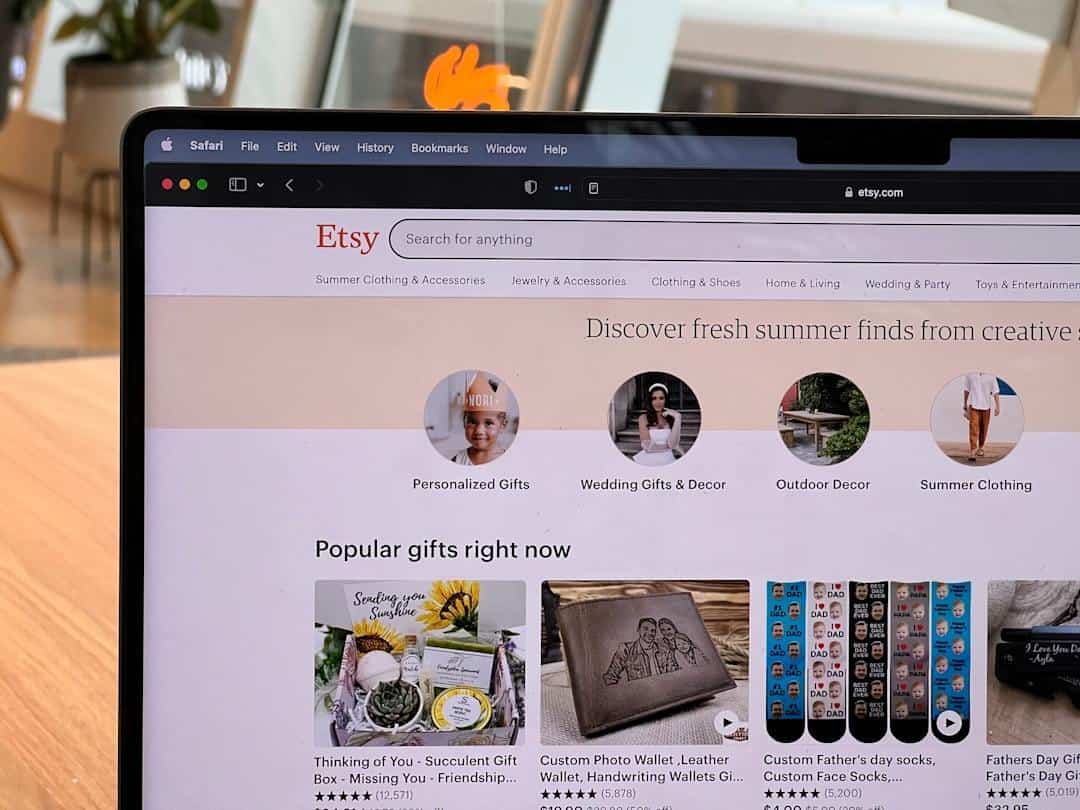If you’re looking to earn money online through your crafts, then you’re in the right place. I made a guide on how to sell top Etsy products to help you turn your creative passion into a thriving business.
You’ll learn about creating standout products, setting up your Etsy shop, and marketing. Keep reading so that you can discover how to sell profitable digital products on Etsy and thrive while doing it.
What Makes Selling Digital Downloads So Appealing?
First things first – what exactly are digital products? Digital products are any product delivered to the customer electronically—think eBooks, design templates, print-on-demand prints, fonts, or social media templates.
No dealing with physical inventory or shipping headaches—this means less overhead and higher profit margins for you.
Why Sell Digital Products on Etsy?

Making things is fun! And it wouldn’t hurt to sell some of the ones you’ve made for cold, hard cash! The question is, how? Well, you have Etsy for that!
What is Etsy? It’s an online platform now known as a vibrant marketplace. It’s popular as the best place to buy unique, handmade, and vintage items. Besides these, you can also get your craft supplies and various digital products there.
Additionally, you get to:
- Swarm Of Leads: It’s not an exaggeration that Etsy has millions of active buyers—91.6 million active buyers in 2024. Even getting a tenth or hundredth of this user base as your customers means you’re bound for success!
- The Right People: People who shop on Etsy value creativity, uniqueness, and quality. If you incorporate these three factors into your products, you can attract most of the customer base.
- Ease Of Use: Can you use social media like Facebook? If so, you can easily use Etsy as well! After a few days or a week, you can start selling and focus on making money from your digital downloads.
- The Profit’s Good: Of course, Etsy is still a business and will take a cut—through listing, transaction, and payment processing fees—from your profit. Thankfully, it’s relatively low compared to other online marketplaces.
- Reach Of A Giant: Etsy isn’t just a US thing! Its customer base and users are located worldwide. If you think your product is too niche in the Americas, someone on the other side of the world will definitely want it!
- The Community’s Supportive: Aside from the internet, you can get help and support from Etsy’s community. The company’s customer service also provides a supportive environment for Etsy sellers, with resources, forums, and tools designed to help you succeed.
- Benefits Of Built-in SEO: You don’t need to worry about SEO, keyword tools, or any technical internet stuff. Etsy has already done that for you, which is evident as it leads in search engine results when it comes to online crafts.
Imagine making a sale on the best-selling digital products while sipping your morning coffee—that’s the beauty of passive income. Digital products on Etsy make it achievable. Etsy’s established system handles payments, freeing you from navigating the technicalities of secure transactions.
A Step-by-Step Guide on How to Sell Digital Products on Etsy
Ready to get your creations out there? Then here are the steps to help you every step of the way, from launching your digital product business to attracting eager customers and transforming your creative skills into a profitable Etsy store.
Step 1: Finding Your Niche

Avoid being just another face in the crowd—well, who wants that anyway? So, zero in on a specific niche when learning how to sell digital products on Etsy successfully.
A well-defined niche lets you target a specific group with products they’ll love. This not only sets you up as a go-to expert in your area but also streamlines marketing.
For instance, instead of just selling “printable planners,” narrow it down to “printable planners for busy moms.” Or why not “printable planners for moms working from home.”
Focusing on a specific niche makes marketing more efficient. You increase your chances of converting visitors into happy buyers, and it gives you clarity when creating digital downloads your ideal customer can’t resist.
Step 2: Identifying Profitable Digital Products
Once you have a specific niche in mind, identify profitable digital products to sell.
After browsing Etsy for a while, you’ll get giddy about what to sell. You think of what you can make that there’s a market demand for it. What would profit? There’s a lot to think about!
So, it’s one of the challenges, you see. You need to find the best product you can sell so you can have fun and earn more. Of course, as a challenge, you need some help, so here’s a short list of what you can do:
- Know What’s Trendy: If there’s a popular product at the market, jump on the bandwagon and sell them as well! You can easily learn what’s selling by browsing Etsy, which shows trending items, bestsellers, and customer reviews. You can also use tools like Google Trends to find out what people are searching for and buying.
- Learn What You’re Good At: This is critically important as it can let you carve out your niche. Are you good at knitting? Then focus on clothes, beanies, and even socks! Don’t just rely heavily on the trends—take advantage of your special skills!
- Check Competitors: Once you know what trend or niche you’ll focus on, it’s time to take a gander at your competitors! Know their prices and if you’re better than them. Also, research if there’s a particular gap or products they can’t provide that you can. Maybe there’s a need for downloadable planners in a specific design aesthetic or Etsy printables covering a topic nobody’s tackled yet.
- Choose Products That Will Sell Forever: While I asked you to check on trends, try your best not to get into fads. As much as possible, choose a product that will never go out of style and fashion. It can keep you afloat and stable if your product becomes a hit!
- Crunch Numbers: Once you have an idea of what to sell, it’s time to know if it’s worth making and selling. Take some time to create a spreadsheet and list how much money you can make selling it. Etsy can eat up your sales if you don’t price them right, but you can gain a large amount if your sales are more than the fees you pay to Etsy.
Now, you’ve decided on a product you think is profitable. What better else to do but to test a few batches and see if you can make a killing on the market. Be sure to conduct surveys, seek feedback, and track your sales. If it doesn’t work, try another product or tweak your marketing strategies.
Step 3: Creating High-Quality Etsy Digital Products

It doesn’t matter if you have a product you think will sell if you don’t make it good enough for people to buy. Remember that you must create high-quality products that will capture the attention of potential leads and keep them coming back for more.
If you need help in this aspect, here is some advice I can give:
- Get the Right Tools: If you’re into digital products, try spending some cash on Adobe Creative Cloud All Apps (containing Adobe Photoshop, Adobe Illustrator, etc.), Canva, or Procreate to help you craft polished products. You can also find many helpful tools on Amazon to create digital products or DIY projects.
- Laserfocus on Quality: Products have specific characteristics that make them high-quality. High-resolution prints are good, and good yarn makes knits stand out. Know the specific quality that makes your product high-quality, and focus on it.
- Please Your Customers: The best customer service is ensuring that the products will make your customers happy. It must offer real value and make your buyers think that you’re not just up for a quick buck. Offer unique designs, customizable options, or bundled packages. There’s a lot you can do when you’re selling digital products!
- Be Precise With Your Descriptions: It’s critical to give your products some good copy to let buyers know that it’s done with care and attention. This means no grammar mistakes, clear instructions, and well-defined features and benefits. Also, remember to include high-quality images and mockups, if applicable.
Continuously test different aspects of your products and listings, such as pricing, keywords, and design variations. Mix and match different numbers based on your product’s performance and customer reception—that’s the key to knowing whether you’re creating the right ones.
Step 3: Launching Your Digital Store on Etsy
Go to Etsy’s website and click on the “Sell on Etsy” option to start your Etsy journey. Select “Open your Etsy shop” and provide your chosen shop preferences—your language, the shop’s location, and currency settings—and give your store a memorable name.
Choose a name that’s easy to remember, hints at your products, and sets the overall tone you want customers to feel. Craft a short bio in the shop description that highlights your passion and showcases your unique style.
Step 4: Setting Up Your Digital Product Listings

I understand that you’re full of ideas now, and it’s getting exciting, right? Well, before you start selling digital downloads, here are tips you need to consider when listing your digital products:
- Start With A Listing: Navigate to the Etsy homepage and log in to your account. Then, click on “Shop Manager” at the top right corner of the screen. Lastly, select “Listings” from the sidebar and click on the “Add a listing” button.
- Upload High Res Image: Again, don’t forget to upload clear and high-quality images for your listing! Etsy recommends using photos that are at least 2000 pixels wide. Also, try to show different angles and consider including videos as well.
- Write a Compelling Title: Ever wonder why product titles on Amazon are long? That’s because it’s effective to add keywords and be descriptive. However, remember to make the title easy to read and clear, highlighting Etsy keywords to reach your target audience.
- Craft a Good Description: There are three core elements for a good description— key features, usage, and instructions. Be sure to include them, and be as detailed as you can using relevant keywords.
- Set The Price: Of course, don’t forget the price! Remember what I said in the earlier sections—research competitors and consider the price value of your product. Adjust later if needed!
- Select Appropriate Tags And Category: Aside from the keywords, be sure to select the appropriate tags to make it easier for the site to categorize you and people to find you.
- Upload the Digital Files: If you’re selling digital products, then this is the right time to upload them. Do note that you can only upload up to five digital files per listing. Also, ensure you’re using the correct file types and that they’re easily downloadable.
- Set Up Automatic Renewal: Depending on your product, you can set up automatic renewal. Choose renewal if you’re selling digital files and manual if you’re selling physical products. Remember that Etsy charges a small fee for each renewal.
- Publish the Listing: And the best part here is that you publish your listing. Before you do so, review everything. Once everything is okay, hit Publish. You’re good to go and wait for people to buy your product!
Etsy only allows 13 tags on each of your product listings, so choose them carefully. Moreover, when creating descriptions that hook the reader, use a conversational tone. Talk to your customers as if you’re chatting in person. Focus on benefits, weaving in keywords throughout your descriptions.
Step 5: Getting Visible through Marketing Strategies

One of the most critical steps in our guide on how to sell digital products on Etsy is to market your store or product. You’ve poured your creativity into crafting digital products, but that’s only half the battle. It’s time to focus on marketing—which can make or break your online business.
Thankfully, many powerful strategies are available.
Social Media Magic
Social media is your friend here. Consider sharing your listings across your accounts. If it makes sense for you, even start a separate business account or page devoted solely to your digital products.
The best trick is to engage with your audience, answer questions, and show there’s a real person behind your curated digital goods.
You can also consider experimenting with Etsy Ads once you’ve gained a feel for what resonates with your audience. These can boost your listings to the top of search results, increasing visibility.
Etsy Ads help your products reach those who might have otherwise missed them. Participating in the Etsy marketplace takes time but can be very worthwhile if you have in-demand digital products.
Power Up Your Products With These
- High-quality product photography that captures those unique selling propositions.
- Offer discounts to attract your first few customers. Word of mouth goes a long way, especially for Etsy entrepreneurs.
- Participate in Etsy Teams that are relevant to your niche and contribute meaningfully. This is a fantastic way to network.
- Aim for Star Seller Status – nothing screams trustworthiness quite like getting the official Etsy nod of approval.
Harness The Power of Email Marketing
Start building your email list from day one. Offering a discount code for first-time shoppers is a great way to incentivize signups. Once your list is up and running, you can share information about upcoming sales or exciting product launches.
This allows you to cultivate a relationship with your ideal customer. Don’t stop at static images either; consider incorporating lifestyle photos showing your digital products in action.
Step 6: Managing Orders and Customer Service

With a listing on Etsy, you get to enjoy having to manage orders and providing customer service to those who need it. It can be a tough job at first, but in due time, it’ll become second nature to you.
Nonetheless, if this will be your first time doing these tasks, here’s a quick guide:
- Be Consistent: Check your orders daily and be optimistic that someone would buy from you! Also, make sure that you check your email for notifications regarding new orders and customer messages.
- Be Prompt: Regardless of whether it’s an order or a request for customer support, be prompt. Every minute counts, and every hour of delay results in a bad rep and loss of business.
- Be Responsive: Always maintain a friendly, professional tone in all communications and make sure to resolve issues. If you can’t do this, hire someone offshore or an intern to do it for you.
- Be Amenable: If you can, encourage satisfied customers to leave positive reviews. And, of course, on the flip side, respond to negative feedback constructively. Apologize for any inconvenience and offer solutions to make things right.
- Be Supportive: Aside from support calls and messages, you need to support your customer in other ways—probably through content. For example, take advantage of frequently asked questions (FAQs) sections. This can help customers get all the information they need, especially if your product is digital.
- Be Diligent: Etsy has analytics tools to help you track the performance of your listings and identify trends. Monitor the changes and react appropriately. Also, be sure to pay attention to customer feedback to improve your products and service.
- Be Updated: Lastly, keep your listings updated. If information changes about your product, update the listings. And keep posting new products if you have any to keep your shop fresh and engaging.
Scaling Your Etsy Business
Congratulations! You’ve established a successful digital products store on Etsy and are ready to expand your business.
Selling on Etsy is fun and challenging so far, isn’t it? However, starting to scale is when everything gets serious and difficult fast. If you’re unfamiliar, scaling involves expanding your reach, increasing sales, and optimizing your operations. And you can easily get stuck with any of these operations.
To avoid having troubles as you scale, read these:
1. Optimize Your Product Listings
Learn SEO (Search Engine Optimization). Although I say that Etsy is doing this behind the scenes, when you scale, you need to learn and apply it as well.
Start with continuously refining your product titles, descriptions, and tags with relevant keywords to improve visibility in Etsy search results. Also, be familiar with and use tools like Marmalead or eRank to discover trending keywords in your niche.
2. Leverage Social Media And Marketing
I’ve mentioned it above, and I’ll reiterate it here. That’s because there’s no escaping marketing. If you want to grow and scale your business, you need a lot of customers fast. And to do that, you need to leverage social media and marketing on various marketing channels.
However, prioritize your social media presence first. Become present on platforms like Instagram, Pinterest, and Facebook. Share engaging content, product updates, and behind-the-scenes glimpses to connect with your audience. These can help attract potential buyers of your product.
And then there’s email marketing. Start by creating an email list and sending regular newsletters to keep your customers informed about new products, special offers, and updates. Helpful tools for managing your email campaigns are Mailchimp or ConvertKit.
Also, try collaborating with influencers and bloggers in your niche—partner with them to promote your products. Influencer marketing can significantly boost your visibility and credibility.
3. Streamline Operations
As your business grows, you’ll need people to help you. You can begin by outsourcing tedious tasks like graphic design, customer service, and social media management so you can prioritize essential businesses and manufacturing/product creation.
If you’re a bit tech-savvy, look into automation tools. They can handle repetitive tasks like order fulfilment, customer inquiries, and social media posting. Apps like Zapier can help you automate workflows and save time.
4. Build A Strong Brand
Since you’re at the point where you want to scale, you need to build a strong brand. Remember that a consistent, strong brand identity across all platforms can help you solidify your business presence. Start by using the same logo, color scheme, and voice in your communications and products.
Never forget to improve your customer experience. Providing excellent customer service is critical to building a loyal customer base. As mentioned, be sure to respond promptly to inquiries, address concerns, and go the extra mile to exceed customer expectations.
FAQs
What kinds of digital products sell well on Etsy?
The best thing about Etsy is having a buyer for almost anything! Printables, templates, and design elements are very popular. However, you need to check carefully, as some digital products naturally do better than others. Besides the trendy ones, you need to consider solving people’s problems through your digital downloads.
How do I get paid?
It’s easy to receive payments from Etsy. Like other games that pay money directly to your account, Etsy also does it. How often they pay out depends on your account settings. You can even choose to get paid through PayPal, like other games.
Do I need a business license to sell on Etsy?
While only sometimes required, it’s a good idea to check if you need a business license. This depends on where you live and the type of digital products you’re selling.
How much does it cost to sell digital products on Etsy?
Etsy charges a small fee to list your product and takes a percentage of each sale. That’s why part of the step on how to sell digital products on Etsy is to price your digital items right. It’s important to consider these fees when you price your digital products so you don’t lose money.
Conclusion
That’s it! These are some tips on selling digital products on Etsy successfully. The digital age allows anyone, regardless of location, to connect with millions of customers.
Whether you dream of becoming a six-figure Etsy seller, crave time and location freedom, or wish for a fulfilling creative outlet… learning how to sell digital products on Etsy remains one of the most accessible paths toward achieving this.
You can even list your digital products completely free. Just remember that your Etsy digital products won’t sell themselves. Thus, consider following our tips above!






